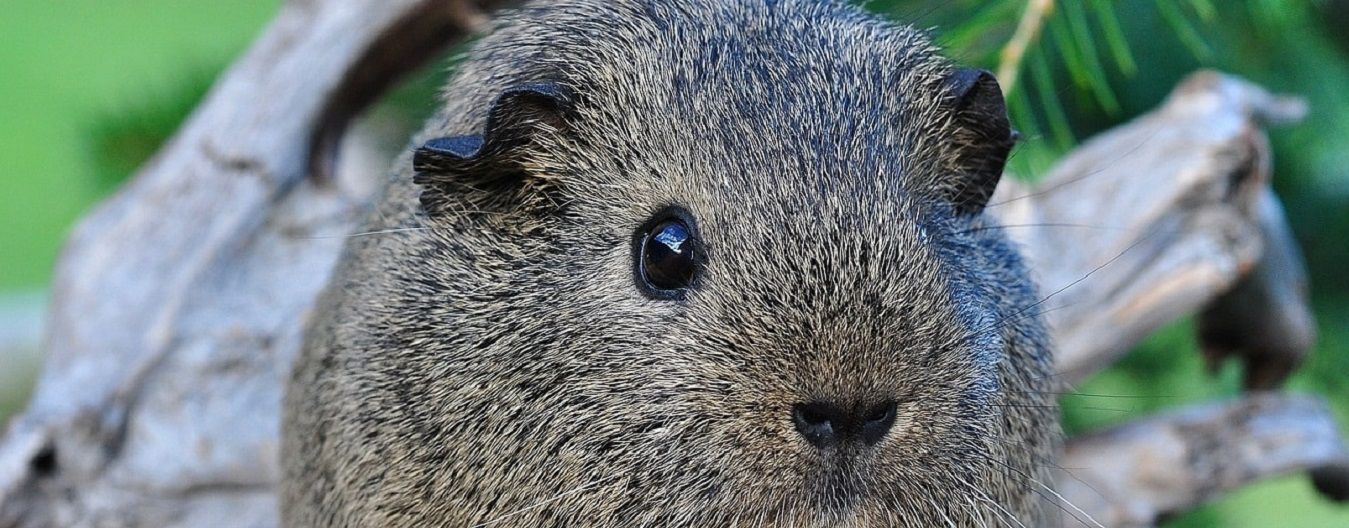

Guinea pigs are rodents which are also known as cavies native to the Andes Mountains of South America. Cavies are related to chinchillas and porcupines and consist of a total of 11 breeds and 23 varieties. The three most common breeds are the Abyssinian (rough, short coat), the American or English (classic shorthair), and the Peruvian (longhair). Guinea pigs are herbivores (vegetable eaters) and they feed continuously and when healthy make frequent, formed fecal pellets. Guinea pigs also normally produce and ingest softer stools, called cecotropes, throughout the day. These provide important proteins and vitamins. Guinea pigs are social and often bonded with 1-2 other guinea pigs in pairs or trios. They can, however, live happily as solo pets. Guinea pigs live on average about 4-5 years, but they may live up to 7-8 years with proper care.
Guinea pigs are best kept in enclosures at least 1’ wide by 2’ long, with walls at least 1’ high. A solid floor is recommended with dust-free bedding (shredded newspaper or commercially available recycled newspaper bedding), which should be changed at least once weekly. Wood shavings are not recommended, as they can be dusty and irritating and are indigestible. Wire-bottom cages are not recommended because they can lead to foot ulcers and entrapment of toes between wires. Fresh water should be provided daily in a sipper bottle and/or an open bowl.
A high fiber diet is essential for optimal guinea pig health. Guinea pigs may be reluctant to try new foods, and it can take weeks for them to recognize new items as food. Always add new items gradually to avoid gastrointestinal upset. Guinea pigs are unusual among rodents in that they have a high dietary requirement for vitamin C. They should receive supplemental vitamin C (in the form of a tablet or a liquid suspension) daily.
Daily diet for an adult guinea pig should include:
If the guinea pig is not overweight, a small amount of high fiber fruit can be offered (apple, peach, plum, pear, melon, raspberry, papaya, blueberry, blackberry, strawberry, pineapple) occasionally
Avoid sugary fruits such as bananas and grapes
Do no feed cereals, bread, oats, corn, seeds, or nuts, as these foods may lead to gastrointestinal upset
Scurvy is probably the most commonly endured health problem in guinea pigs. Young, growing animals are most susceptible. Guinea pigs sick from other diseases also need additional vitamin C. Affected guinea pigs exhibit a rough hair coat and have trouble eating. They often have painful joints and are predisposed to foot sores.
Gastrointestinal (GI) problems are often secondary to dental problems or inappropriate diets. Loss of appetite is common. Guinea pigs are very sensitive to changes in the diet and even a change in brand of pellet may be enough to stop them from eating. They can also develop GI upset from impactions in the stomach and intestines with food and hair. Since they cannot vomit, guinea pigs with GI upset will often grind their teeth, appear bloated, and pass small, hard stools or no stool at all. These guinea pigs should have their teeth examined for problems and should be treated with fluids, assisted feeding, and sometimes, GI motility enhancing drugs. Rectal impactions in older guinea pigs may occur from build-up of soft stools and loss of anal tone.
Guinea pigs’ teeth grow continually about 10 cm a year. The vegetation in their native environment is tough and fibrous, enabling continual wearing down of the teeth. In our homes, diets low in fiber may lead to the development of overgrown teeth, tooth root abscesses, and sharp spurs on teeth that are painful. Guinea pigs with dental disease will often drool and stop eating and should be examined immediately by an exotics veterinarian.
Hair loss can be self-induced or spontaneous. Stressed or bored guinea pigs may chew their own or their cagemate’s fur. Guinea pigs may also pull and chew at hair over sites of pain, especially on the limbs and abdomen. Other causes of skin problems include mite infestation and ringworm. Both of these conditions may lead to hair loss and itchy, flaky skin. Ringworm is also contagious to people. Guinea pigs that develop skin swellings should be examined for abscesses or tumors. It is important to brush longhaired species regularly to minimize matting and ingestion of hair.
Pressure sores on the bottom of feet or “bumblefoot” are especially a concern in older guinea pigs. Obesity, vitamin C deficiency, and wire bottom cages often predispose guinea pigs to bumblefoot. Affected individuals may be lame, lethargic, and lose their appetites. Severe bumblefoot can lead to bone and joint infections, as well as spread of bacteria through the blood stream to internal organs such as the kidneys.
Pneumonia occurs commonly in guinea pigs. Guinea pigs with respiratory disease exhibit runny eyes and nose, coughing, sneezing, weight loss, and difficulty breathing.
Sexual maturity occurs early in guinea pigs, with females being able to breed at 4-6 weeks and males at 9-10 weeks of age. If females are going to be allowed to mate, they should be bred prior to 6 months of age to lessen the likelihood of dystocia (trouble giving birth). Signs of a pregnant guinea pig in distress include lethargy, depression, straining for more than 30 minutes, and bloody or greenish-brown vaginal discharge.
Urinary stones often develop in guinea pigs as a consequence of too much calcium in the diet (excessive alfalfa hay or an overabundance of alfalfa-based pellets). A guinea pig with urinary stones may have bloody urine, straining to urinate and present with a hunched posture.
Obesity is common in guinea pigs and is due to improper diet (too many pellets or treats) and lack of exercise. Obesity can lead to lameness and sores on feet, inability to groom (urine and fecal accumulation on coat), reproductive problems, and GI motility issues.
Recommended Veterinary Care for Your Guinea Pig
Yearly physical exams include: